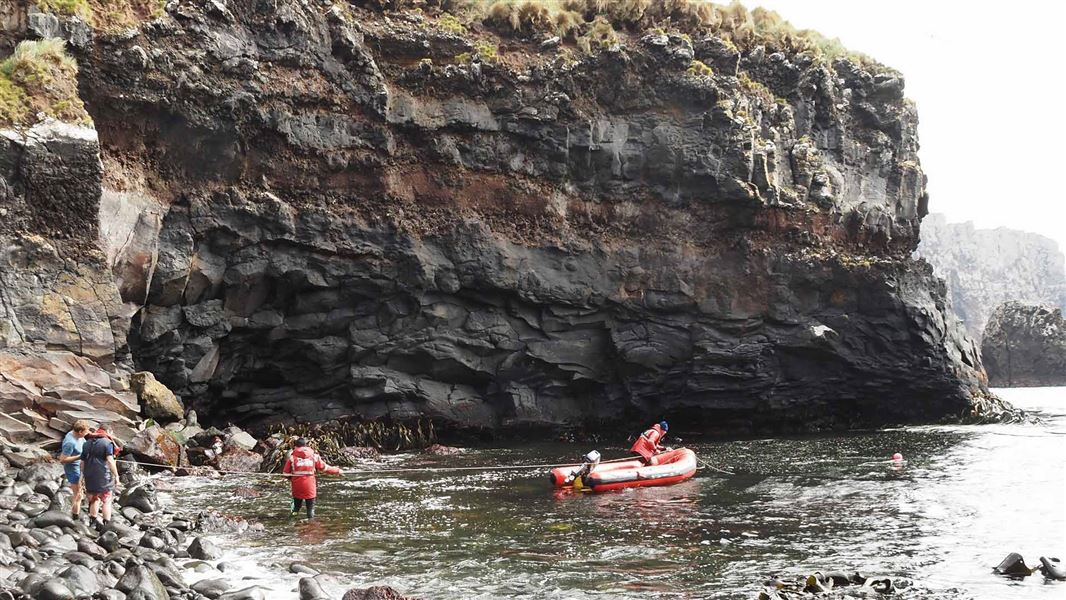Archived content: This media release was accurate on the date of publication.
Date: 17 March 2020
The Antipodean albatross population has declined by two thirds over the last fifteen years from around 16,000 breeding birds to 6,000. The major threat to these birds is being accidentally caught by longline fishing vessels, mainly on the high seas, outside New Zealand waters.
DOC scientists Kath Walker and Graeme Elliott will attach small GPS transmitters to the albatrosses so the birds can be tracked while they forage at sea. This will enable DOC and Fisheries NZ to better understand where the birds are flying and where they encounter fishing vessels.
The female population is being affected more severely than the males. Oceanic changes are thought to have driven the females to forage further north and east of New Zealand, pushing them into waters where they are at greater risk from international longline fishing fleets.
Graeme says: “Year after year we see the same male albatrosses arriving at the colony and waiting by their nest for their dead partners to return. It's heart-wrenching to watch.”
Live Ocean, a new marine conservation charity set up by Peter Burling and Blair Tuke partnered with Southern Seabirds Solutions Trust on the project. Live Ocean raised $70,000 to help pay for the satellite trackers which will substantially increase the number of transmitters that Fisheries New Zealand and DOC have provided.
“The data provided by these satellite trackers is the first step in saving this iconic species. Millions of years in evolution and they could be gone in as few as 20 years. Kath and Graeme are absolute legends and we’re looking forward to following both their journey and the albatrosses,” says Peter Burling.
Satellite trackers on albatrosses can pinpoint the exact location (within a few metres) of the bird in near real-time. The birds can be monitored via the albatross tracker app which was developed by DOC and FNZ. Their flight paths can be overlaid with the activity of individual fishing vessels to identify those posing most risk of bycatch.
Kath Walker and Graeme Elliott have been studying these albatrosses for more than two decades and aim to understand the flight paths of these birds so governments, environmental interests and other influencers can work with the fleets most likely to be causing risk to these birds. The urgent need is to reduce deaths of Antipodean albatross by fleets using fishing practices that keep them and other seabirds safe on high seas vessels.
Background information
Antipodean albatrosses only breed in New Zealand, on the Antipodean Islands 750km south-east of Dunedin. They have a three-metre wingspan and are known for their exceptional navigational and voyaging ability and spend most of their life at sea.
This albatross is listed as ‘Nationally Critical’ under the New Zealand Threat Classification System, the highest threat classification. The Antipodean albatross is also listed on the highest appendix in the international Convention for Migratory Species and is recognised a population of conservation concern by the Agreement on the Conservation of Albatrosses and Petrels.
New Zealand is the ‘Seabird capital of the world’; more species of seabirds breed on our mainland and offshore islands than any other country in the world. The diversity of albatrosses NZ has is incredible - 13 varieties, head and shoulders above any other country.
The recent MFE State of our Marine Environment 2019 shows that 90% of our native seabirds are threatened or at risk of extinction.
Longline fishing vessels can avoid catching albatrosses by using hook-shielding devices to prevent birds becoming hooked, or by the combination of setting baited hooks at night when the birds are less active, adding weights near the hook to sink baited hooks quickly, and deploying a bird-scaring line (tori line) above the point where baited hooks land in the water.
Contact
For media enquiries contact:
Email: media@doc.govt.nz
